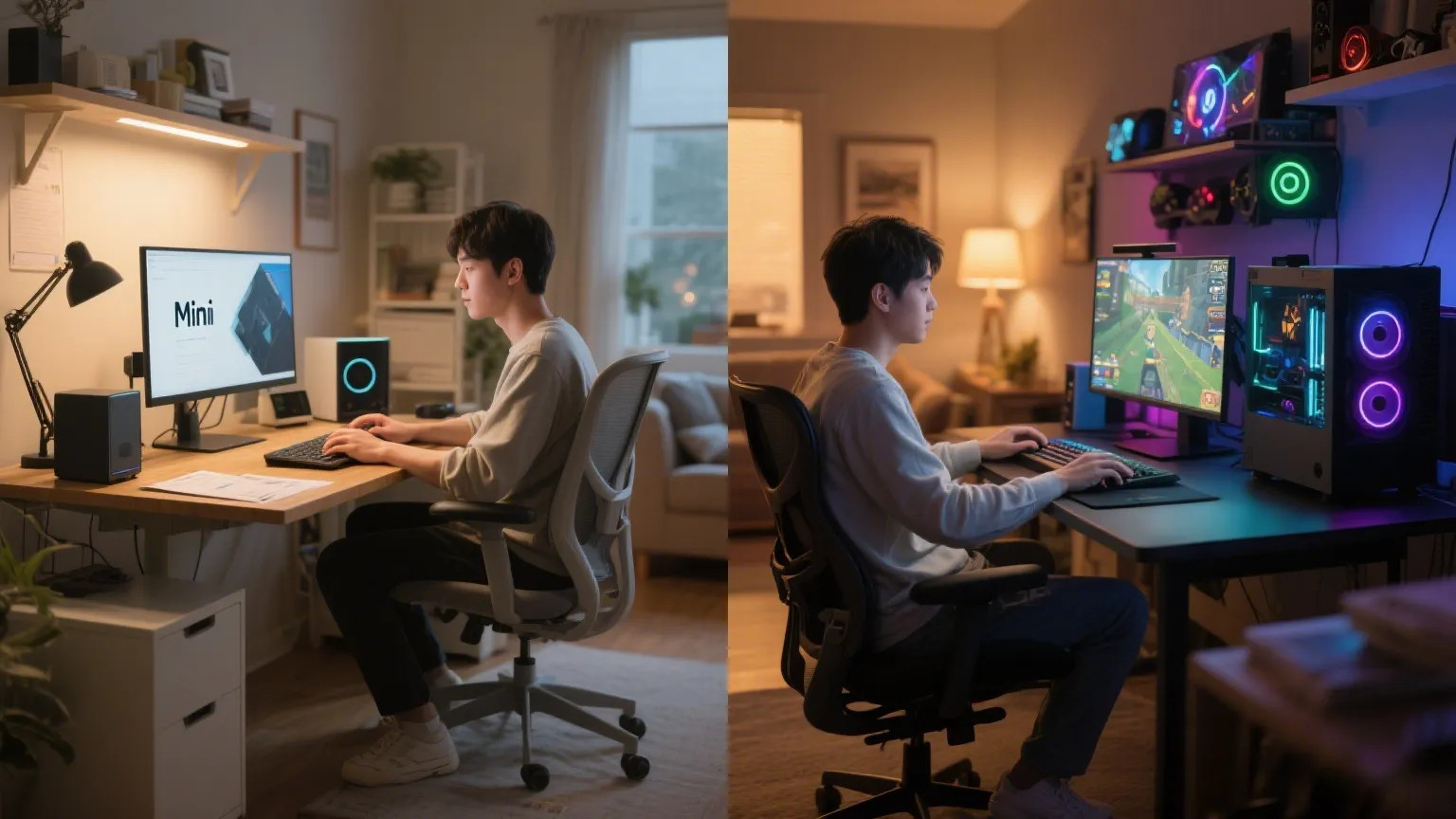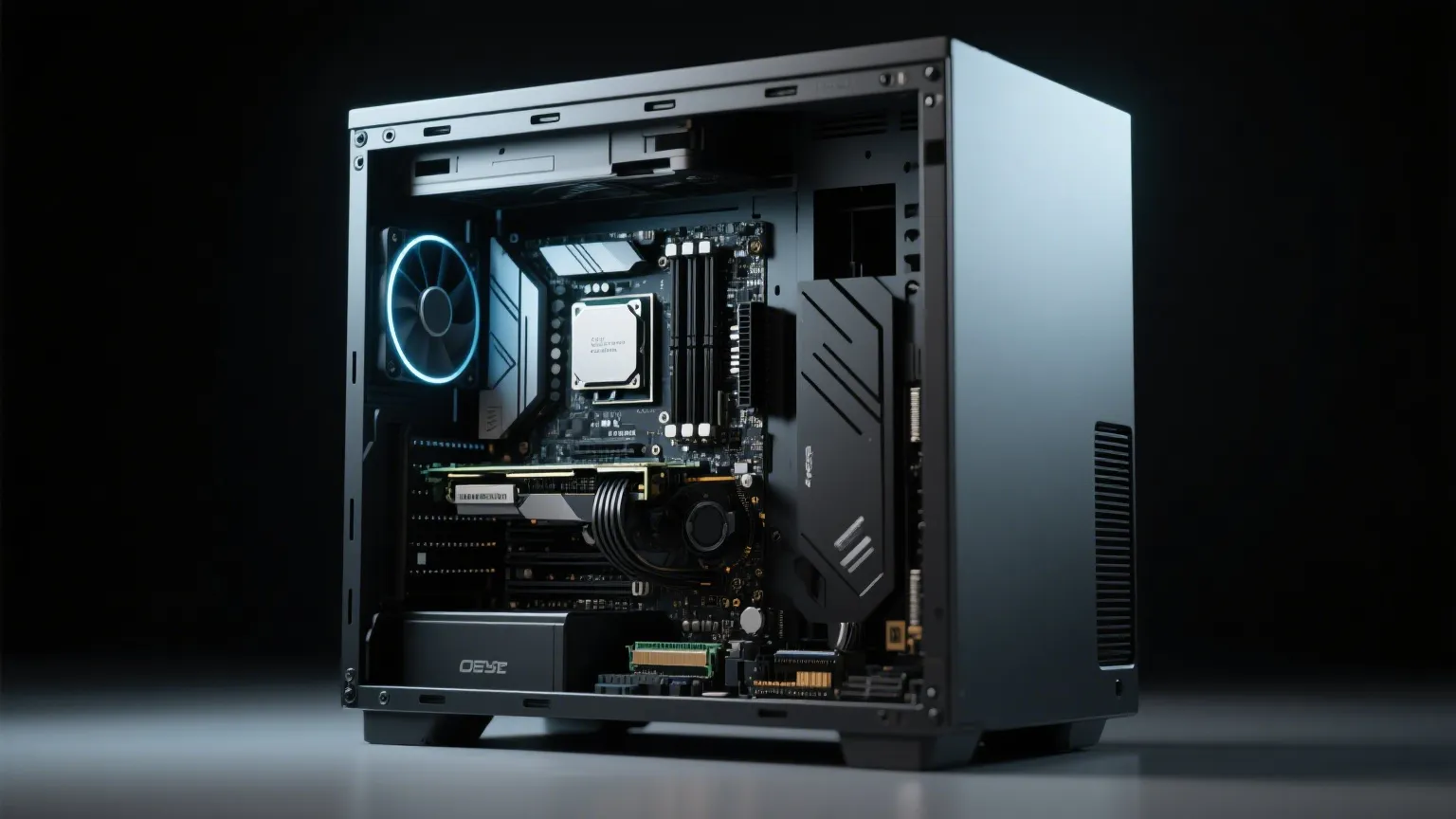As personal and business computing needs evolve, the question of “Mini PC vs. Desktop” has become increasingly relevant. Thanks to technological advancements, the Mini PC has shed its former image as an underpowered secondary device and now serves as a compact, capable solution for light office work, media applications, and even some professional workloads. That said, the traditional desktop computer still holds a strong position, especially when raw performance, customizability, and future-proofing are top priorities. This guide provides an in-depth comparison to help you decide based on your actual needs.

A Mini PC is a desktop-class device with a dramatically reduced physical footprint—typically no larger than a paperback book. Designed for space efficiency, it integrates essential components like the CPU, storage, and thermal management into a streamlined layout, making it easy to tuck behind a monitor, on a shelf, or in a desk corner.
Core characteristics of Mini PCs:
· Low power consumption: Ideal for extended daily use, with typical power draw ranging from 15 to 45 watts under load—far lower than traditional desktops.
· Highly integrated design: Combines key components to save space without sacrificing essential functionality, supporting major operating systems like Windows and Linux.
· Modern performance: Many models now feature Intel’s 12th Gen Core processors or AMD Ryzen chips, fast NVMe SSDs for quick boot times and data access, and dual-channel memory configurations. These upgrades allow Mini PCs to handle routine business tasks, multi-tab browsing, video conferencing, and even light media editing with stability.
· Everyday versatility: Excels at office software (word processors, spreadsheets), web browsing, media streaming, and virtual meetings—perfect for home users, students, and remote workers.
Gone are the days of underpowered Mini PCs. Today’s models leverage advanced hardware to deliver surprising efficiency, making them a viable alternative to desktops for non-intensive workloads.
A traditional desktop is a full-sized machine built from modular components housed in a standalone case, including a motherboard, power supply unit, CPU, RAM, storage drives, graphics card, and cooling systems. Its greatest strength lies in customization and maintainability.
Core capabilities of desktops:
· Broad hardware compatibility: Allows users to mix and match components, from CPUs (like Intel Core i9 or AMD Ryzen 9) to dedicated GPUs (such as NVIDIA RTX 4080 or AMD Radeon RX 7900 XTX).
· Expandable storage: Supports multiple SSDs, HDDs, and even RAID configurations for redundant or high-capacity storage needs.
· Easy upgrades: Incremental improvements—adding more RAM, swapping in a faster GPU, or upgrading to a larger SSD—are straightforward, extending the system’s lifespan.
· Superior thermal design: Features robust cooling (including liquid cooling or high-performance air cooling) to handle sustained high-performance workloads like gaming, 4K video editing, and 3D modeling.
The tradeoff? Desktops are bulky, power-hungry (consuming 200 to 600+ watts), and require careful cable management—less ideal for small spaces.

Mini PCs prioritize compactness over flexibility: Most components (CPU, GPU) are soldered or hard to access, limiting upgrades to RAM (dual-channel configurations in some models) or storage (single M.2 NVMe slot or 2.5-inch SATA bay in many). Higher-end models may support external GPUs via Thunderbolt ports, but options are limited.
Desktops thrive here: With multiple RAM slots (often 4+), support for dedicated GPUs, and room for multiple storage drives, they adapt to growing needs—whether adding a second NVMe SSD for faster file access or upgrading to a more powerful GPU for gaming.
Mini PCs shine in efficiency: Low power draw reduces electricity bills, and their compact design (including fanless models) ensures near-silent operation—ideal for libraries, home studios, or shared offices. Even models with fans run quietly, thanks to efficient thermal management.
Desktops, with their powerful components, require active cooling (fans, liquid cooling systems) that adds noise. Their higher power consumption also increases long-term energy costs, making them less suited for 24/7 use in energy-conscious settings.
· Desktops: The gold standard for gaming and intensive tasks. Dedicated GPUs, overclockable CPUs, and robust cooling handle modern AAA games (with ray tracing), 4K video editing in DaVinci Resolve, and 3D modeling in Blender with ease.
· Mini PCs: Cater to casual gamers or cloud gaming users. Integrated GPUs (like Intel Iris Xe or AMD Radeon Vega) can run older titles or light games, but struggle with modern AAA releases. However, cloud gaming platforms (NVIDIA GeForce Now, Xbox Cloud Gaming) let Mini PCs stream high-end games via a fast internet connection.
For light to moderate tasks—word processing, spreadsheets, video conferencing (Zoom, Microsoft Teams), and multi-tab browsing—Mini PCs excel. Their fast boot times (thanks to NVMe SSDs), low noise, and small footprint make them ideal for clutter-free home offices or remote work setups.
Desktops are better for power users: Software developers running virtual machines, data analysts processing large datasets, or professionals using resource-heavy tools (like Adobe Creative Cloud suite) benefit from their multitasking power and reduced latency.
Desktops are preferred for professional creative work: Dedicated GPUs accelerate video rendering in Adobe Premiere Pro, photo editing in Photoshop, and music production with multiple VST plugins. Their higher RAM capacity (up to 128GB+) and fast storage handle large project files smoothly.
Mini PCs are closing the gap for entry-level creators: Integrated graphics support 4K video playback and basic editing in Adobe Premiere Rush or DaVinci Resolve, making them viable for educators, content teams in small spaces, or hobbyists.
|
Cost Category |
Mini PC |
Desktop |
|
Initial Cost |
Lower ($200–$800) |
Higher ($400–$2,000+) |
|
Maintenance |
Minimal (few moving parts) |
Moderate (cooling upkeep, cable management) |
|
Upgrade Costs |
Low (RAM/storage only) |
Higher (GPU, CPU, motherboard swaps) |
|
Lifespan ROI |
High short-term (5–7 years) |
High long-term (with upgrades) |
Mini PCs are space-saving champions: Their small size (often <1L) lets them mount behind monitors (VESA-compatible) or fit in tight corners, maximizing desk space. They’re also portable—easily packed in a backpack for business trips or remote work setups.
Desktops are stationary: Bulky cases require dedicated space, and their weight/cables make frequent relocation difficult, even for small form-factor models.
Mini PCs offer enterprise-grade features: Many include TPM (Trusted Platform Module) for data encryption, secure boot, and BitLocker support—critical for business environments. Their few moving parts reduce mechanical failures, ensuring reliability for daily use.
Desktops, with modular components, allow for security upgrades (like adding a hardware firewall card) and easy replacement of faulty parts (e.g., a failing PSU), enhancing long-term reliability in professional settings.
|
User Profile |
Recommended Option |
Why? |
|
Home users, students |
Mini PC |
Compact, energy-efficient, handles web browsing, streaming, and homework. |
|
Gamers, 3D artists |
Desktop |
Dedicated GPUs and upgradeability for high-performance tasks. |
|
Remote workers, small businesses |
Mini PC |
Saves space, low noise, and cost-effective for office software and video calls. |
|
IT admins, developers |
Desktop |
Customizable for servers, virtual machines, and heavy multitasking. |
|
Entry-level creators |
Mini PC |
Handles light video editing (Adobe Premiere Rush) and 4K playback. |
|
Professional editors |
Desktop |
Power for 4K/8K editing, large project files, and GPU-accelerated tools. |
Mini PCs are ideal if you prioritize space, efficiency, and affordability for everyday tasks—home use, remote work, or light creative projects. They leverage modern components (Intel 12th Gen, AMD Ryzen, NVMe SSDs) to deliver surprising performance without the bulk.
Desktops remain unmatched for heavy workloads—gaming, professional editing, or customizable setups—offering the power, upgradeability, and cooling needed for demanding tasks.
By aligning your choice with your usage (and keeping an eye on key terms like dual-channel memory, dedicated GPUs, or Thunderbolt ports), you’ll find the perfect fit.
Q: Are Mini PCs powerful enough for multitasking?
A: Yes—with dual-channel memory and modern CPUs (Intel Core i5, AMD Ryzen 5), they handle multiple apps (browser, word processor, video call) smoothly.
Q: Can desktops support multiple monitors?
A: Absolutely—dedicated GPUs often have 3+ ports (HDMI, DisplayPort) for dual or triple monitor setups, ideal for multitasking.
Q: Do Mini PCs support 4K video?
A: Many do—integrated GPUs in modern models handle 4K streaming and light editing, though desktops with dedicated GPUs excel at 4K rendering.
Q: Which is more durable?
A: Mini PCs have fewer moving parts, reducing mechanical failures (5–7 year lifespan). Desktops last longer with upgrades, as components can be replaced individually.
Q: Can a Mini PC replace a desktop for business use?
A: For standard tasks (ERP, CRM, video conferencing), yes. Industries needing GPU acceleration (e.g., AI, 3D design) still benefit from desktops.

Click to confirm
Cancel